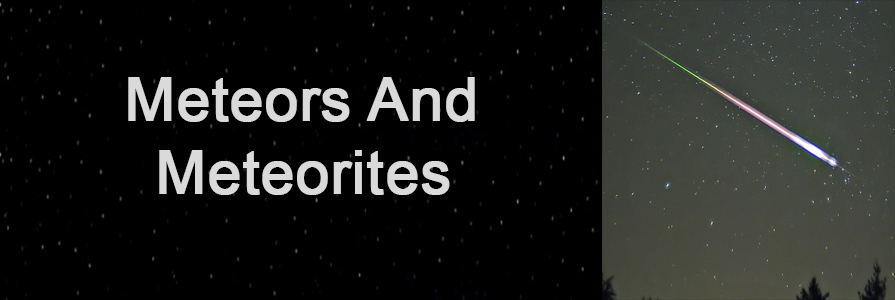
What Exactly Are Meteoroids, Meteors And Meteorites
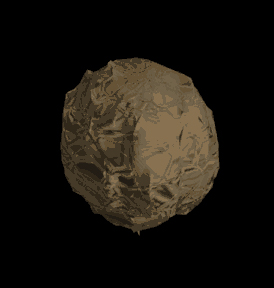
A meteoroid is a small rocky or metallic body in "outer space." See an artists rendering of a meteoroid to the left. Once a meteoroid enters the earth's atmosphere it is called a meteor. If a meteor survives traveling through the atmosphere and lands on earth, it is called a meteorite. When a meteoroid enters the earth's atmosphere and then vaporizes, it becomes a meteor which is often called a shooting star.
Objects in outer space that are much larger than a few meters are classified as asteroids. Asteroids are also mainly made of rocky and iron materials. Most asteroids orbit about the sun and rarely crash into the earth. The last known asteroid "impact event" was the Tunguska event, which occurred in Siberia, Russia, in 1908. Asteroids are rocky bodies that "do not have an atmosphere". However, a few have their own moons. Our solar system contains millions of asteroids.
A comet is an small icy body with an atmosphere that when passing close to the sun heats up and begins to outgas displaying a surrounding "coma" (a visible atmosphere) and at times a tail. This phenomena is due to the effects of the solar wind upon the nucleus of the comet.
Meteoroids are significantly smaller than asteroids and comets, and range in size from small grains to several meter wide objects. The exact maximum size has never formally been agreed upon. However, the largest meteorite ever found (Hoba Meteorite in Namibia) on earth is 2.7 meters in length and estimated to weigh 60 tons. So roughly, meteoroids, meteors and meteorites are objects from outer space that are less than about 3 meters wide (about 10 feet in length). Top
Our Solar System
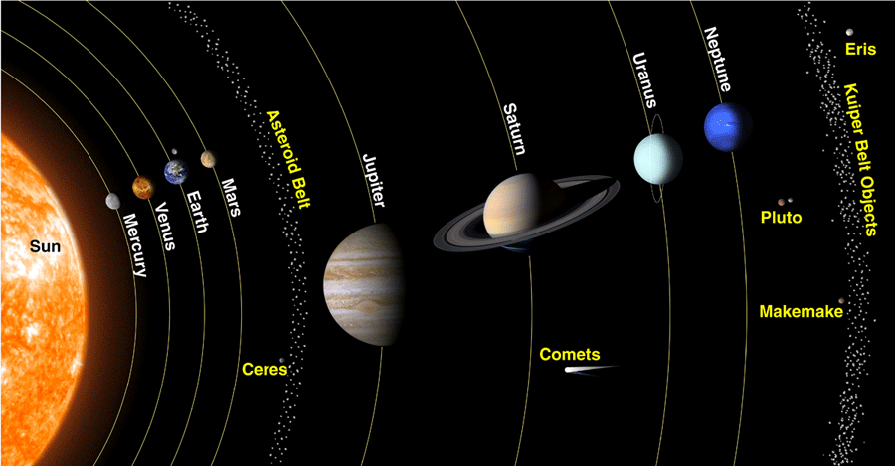
(Picture not to scale.)
Formation Of Asteroids and Meteoroids
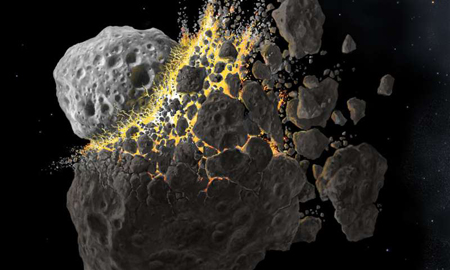
Most asteroids and meteoroids are thought to originate from the splintering of a handful of minor planets formed during the infancy of our solar system a recent study shows. See the artists conception to the left of a small asteroid splintering a much larger one. Most of the asteroids and meteroids are thought to be the shattered remnants of planetesimals – bodies within the early Sun's Heliosphere that never grew large enough to become planets.
The study, in Nature Astronomy, found at least 85 percent of a sample of 200,000 asteroids in the inner Asteroid Belt (which is the main source of meteoroids that make contact with the earth) originate from just five ancient minor planets that were decemated. The names of the ancient planets are Flora, Vesta, Nysa, Polana and Eulalia.
"Some of the remaining 15 percent may also trace their origins to the same group of primordial bodies, but more likely, a few ghost planetesimals", said Stanley Dermott lead author of the study and a theoretical astronomer at the University of Florida.
The ancient planetesimals are considered remnants from the giant cloud of gas and dust that condensed to create the sun, planets, and smaller objets some 4.5 to 5.0 billion years ago. Today, most asteroids and meteoroids orbit the sun in the tightly packed Asteroid Belt located between Mars and Jupiter. (See the Asteroid Belt in the large photo directly above.) Top
Various Types Of Meteoroids
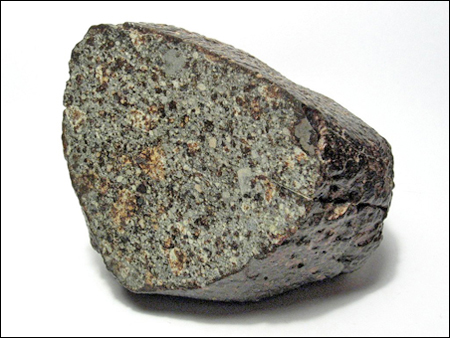
Chondrites. About 86% of meteorites are chondrites, which are named for the small, round particles they contain. See the chondrite photo to the left. The small round particles, called chondrules, are embedded in molten grains of dust, grit and clay. The chondrules are composed mostly of silicate minerals that appear to have melted while they were free floating objects in space.
Certain types of chondrites also contain small amounts of organic matter, including amino acids, and pre-solar grains. Chondrites are typically about 4.55 billion years old. Chondrites are some of the oldest and most primitive materials in the solar system. Chondrites are often considered to be "the building blocks of the planets".
Achondrites. About 8% of the meteorites are achondrites (meaning they do not contain chondrules), some of which are similar to terrestrial igneous rocks. Most achondrites are just ancient rocks, and are thought to represent the crustal material of the planetesimals. One large family of achondrites (the HED meteorites) may have originated on the parent body of the Vesta Family, although this claim is disputed.
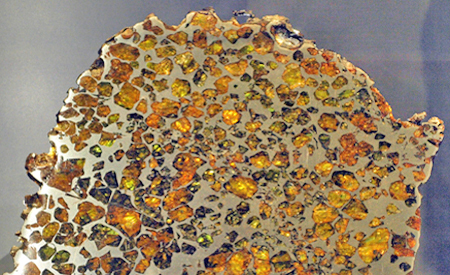
Iron Meteorites. About 5% of meteorites that have fallen are iron meteorites composed of iron-nickel alloys. Most iron meteorites are thought to have come from the cores of planetesimals that were once molten. As with the earth, the denser metal separated from the silicate material and sank towards the center of the planetesimal, forming its core. See the next section below for more on iron meteorites.
Stony-iron Meteorites. Stony-iron meteorites constitute the remaining 1%. They are a mixture of iron-nickel metal and silicate minerals. One type, called pallasites is thought to have originated in the planetesimal boundary zone above the core regions where the iron meteorites originate.
See the cut and polished slice of the Esquel meteorite to the left. This pallasite meteorite was found near Esquel, a patagonian (native tribes) town in the southern region of Argentina. It is a type of stony-iron meteorite that, when cut and polished, shows yellowish olivine (greenish) crystals. The yellow-green crystals are encased in an iron-nickel body. Top
Iron Meteorites
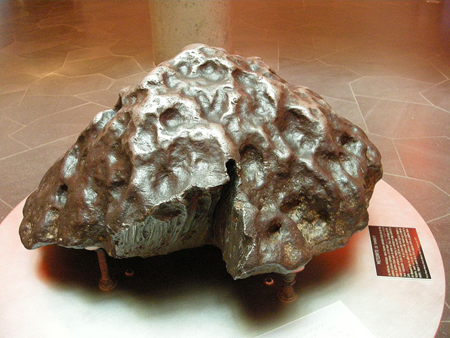
The iron meteorite to the left, Tamentit, is huge - 2,200 pounds, and was discovered near the town of Tamentit in south-central Nigeria. It was found in 1864 in the Sahara Desert (the largest land dessert). It is currently on display at Vulcania Park in France.
Although they are fairly rare compared to the stony meteorites, comprising only about 5% of all found meteorites, iron meteorites have historically been heavily over-represented in meteorite collections due to several factors:
- They are easily recognized as unusual even by laymen, as opposed to stony meteorites.
- Modern-day searches for meteorites in deserts and Antarctica yield a much more representative sample of meteorites
- They are much more resistant to erosion.
- They are much more likely to survive atmospheric entry, and are more resistant to weather wear. Hence, they are more likely to be found as large pieces.
- All the largest known meteorites are made of iron.
- They can be found even when buried by use of surface metal detecting equipment due to their metallic composition.
Most iron meteorites have been linked to metallic type asteroids because both have similar spectral characteristics in the visible and near-infrared. The overwhelming bulk of these meteorites consists of the iron-nickel alloys kamacite and taenite. Iron meteorites are thought to be the fragments of the cores of larger ancient "metallic asteroids" that have been shattered by impacts. Chemical and isotope analysis indicates that at least about 50 distinct parent bodies were involved. This implies that there were once at least 50 large asteroids in the asteroid belt – many more than today. Top
The Hoba Meteorite
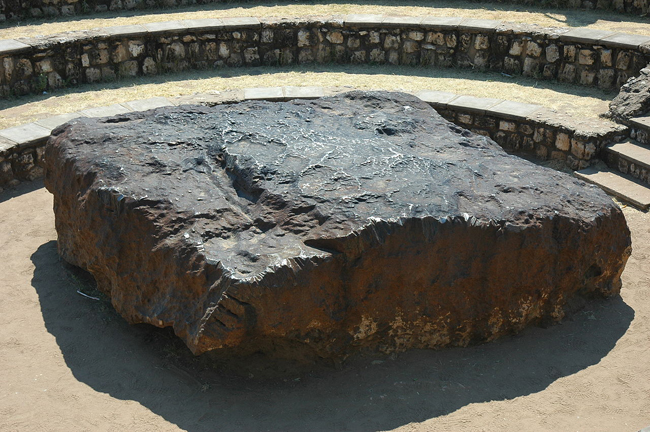
The Hoba Meteorite, is a huge meteorite that lies in Namibia, South Africa. It has been uncovered but, because of its large mass, has never been moved from where it fell. The name "Hoba" means "gift".
The meteorite is estimated to be more than 60 tons, making it the largest known meteorite as a single piece. It is also the most massive naturally occurring piece of iron known on earth's surface. The meteorite is very unusual in that it is flat on both major surfaces.
The Hoba meteorite's impact is believed to have occurred about 80,000 years ago. It is probable that earth's atmosphere slowed the object to the point that it impacted the surface at "terminal velocity" (the steady state maximum velocity of an object in air) thereby remaining intact and causing little excavation. The meteor would have been slowed to about 0.32 km/sec (720 miles per hour) from its speed on entering the earth's atmosphere, typically about 10 km/sec (22,500 mph) for similar objects.
Hoba is a body of metal, measuring 2.7×2.7×0.9 meters (8.9×8.9×3.0 ft). In 1920 its mass was estimated at 66 tons. Erosion, scientific sampling and vandalism reduced its bulk over the years. The remaining mass is estimated at just over 60 tons. The meteorite is composed of about 84% iron and 16% nickel, with traces of cobalt. A crust of iron hydroxides is locally present on the surface, owing to weathering.
In an attempt to control vandalism, the government of South West Africa (now Namibia) on March 15, 1955, declared the Hoba meteorite to be a national monument. In 1979 the proclamation was changed to include not only the meteorite but also 25 meters x 25 meters of land on which it is situated. In 1987 Mr. J. Engelbrecht, the owner of the Hoba West farm, donated the meteorite and the site where it lies to the state for educational purposes. Later that year, the government opened a tourist center at the site. As a result of these developments, vandalism of the Hoba meteorite has ceased and it is now visited by thousands of tourists every year. (Thanks to Wikipedia for the above information.) Top
Lunar (Moon) Meteroites
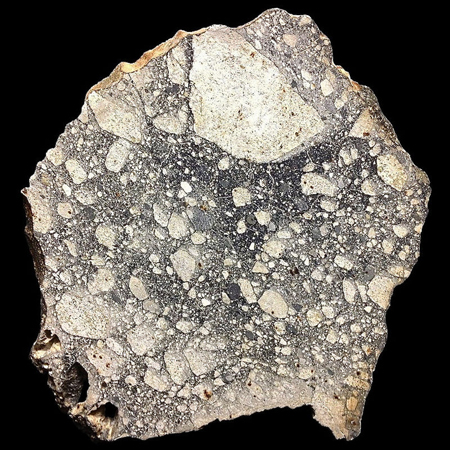
A "lunar meteorite" is a meteorite that is known to have originated on the Moon. About one in every thousand newly discovered meteorites is a lunar meteorite, whereas the vast majority of meteorites are from the asteroid belt. (In the early 19th century most scientists believed that all meteorites falling towards the earth were from the Moon.) As of August 2017, about 306 lunar meteorites have been discovered.
Pictured to the left is a large slice of Northwest Africa (NWA) 5000, the largest known lunar meteorite. It was found in the Sahara desert in 2007. NWA 5000 is very ancient and much older than most known earth rocks. It is much larger than any item brought back in the Apollo collection. NWA 5000 before cutting was about 10 in. by 9 in. by 4 in. and weighed a bit over 13 pounds. it was also the most metal rich moon rock ever found.
While on the moon's surface, NWA 5000 was exposed to the solar wind, which implanted hydrogen-rich gas bubbles. It was ejected from the moon by an asteroid strike about 2,000 years ago. It then hurtled through space and orbited around the sun about 25,000 miles per hour. After traveling around in space for about a 1,000 years, NWA 5000 intercepted the earth’s orbit and was pulled in by its gravity.
Originally, it was probably the size of a basketball. As it hit the earth’s atmosphere its surface began to heat up and give off light making it a meteor. Material began to ablate, spalling off a glowing trail of ionized gas and dust (like the picture at the very top of this page). During its entry phase into the atmosphere it lost about half of its mass becoming about the size of a bowling ball.
The earth’s atmosphere acting as a brake, probably slowed NWA 5000 down to about 185 miles per hour at about 10 miles high (the top of the troposphere) terminating the ablation process. (Most meteors do not survive this part of the trip and never become meteorites.) Meteor NWA 5000 then dropped to earth only under the influence of gravity and landed in the desert of the Western Sahara about 1,000 years ago.
All six of the Apollo missions on which samples were collected landed in the central nearside of the Moon, an area that has subsequently been shown to be geochemically the same. In contrast, the numerous lunar meteorites are random samples of the Moon and consequently provide a more representative sampling of the lunar surface than the Apollo samples. Half the lunar meteorites, for example, likely sample material from the farside of the Moon. Top
Martian Meteroites
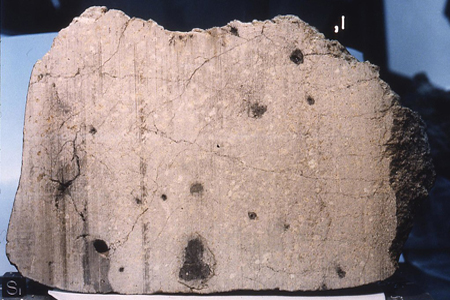
A Martian meteorite is a rock that formed on the planet Mars and was then ejected from Mars by the impact of an asteroid or comet, and finally landed on the Earth. Of over 61,000 meteorites that have been found on Earth, 214 were identified as Martian as of October 2018.
The 214 meteorites are thought to be from Mars because they have elemental and isotopic compositions that are similar to rocks and atmosphere gases analyzed by spacecraft on Mars. In October 2013, NASA confirmed, based on analysis of argon in the Martian atmosphere by the Mars Curiosity rover, that certain meteorites found on Earth thought to be from Mars were indeed from Mars.
See the meteorite EET 79001 to the left, which was found in Elephant Moraine in Antarctica during the 1979–1980 collecting season.
By the very early 1980s, it was obvious that the SNC group of meteorites (Shergottites, Nakhlites, Chassignites) were significantly different from other meteorite types. Among these differences were younger formation ages, a different oxygen isotopic composition, the presence of aqueous weathering products, and some similarity in chemical composition to analyses of the Martian surface rocks in 1976 by the two Viking landed space probes. Several scientists suggested these characteristics implied the origin of SNC meteorites was from Mars.
Then in 1983, various trapped gases were found in the EET 79001 meteorite (pictured above). These gases closely resembled those in the Martian atmosphere analyzed by the Viking probes. These trapped gases provided direct evidence for a Martian origin. In 2000, an article by Treiman, Gleason and Bogard gave a survey of all the arguments used to conclude the SNC meteorites (of which 14 had been found at the time) were from Mars. They wrote, "There seems little likelihood that the SNCs are not from Mars. If they were from another planetary body, it would have to be substantially identical to Mars as it now is understood."
The Viking program consisted of a pair of American space probes sent to Mars in 1976 - Viking 1 and Viking 2. Each spacecraft was composed of two main parts: an orbiter designed to photograph the surface of Mars from orbit, and a lander designed to study the planet from the surface. The orbiters also served as communication relays for the landers once they touched down. The project cost roughly 1 billion USD in 1970s dollars, equivalent to about 5 billion USD in 2017 dollars. The mission was considered very successful and is credited with helping to form most of the body of knowledge about Mars through the late 1990s and early 2000s. Top
Meteroites - The Source Of Life?
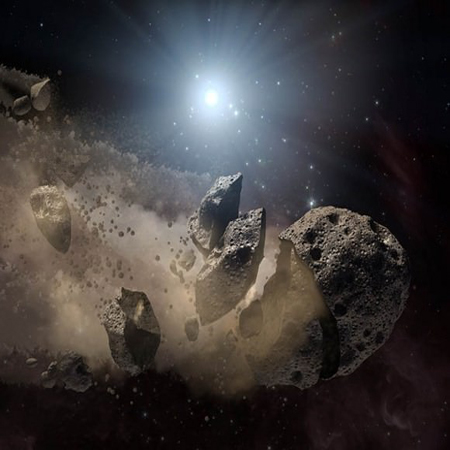
For 50 years, scientists have debated whether the components of DNA - the molecule central to all life on earth - could spontaneously form in space. A new analysis of a dozen meteorites found in Antarctica and elsewhere presents the strongest evidence yet that the answer might be "yes".
"Meteorites may have served as a molecular kit providing essential ingredients for the origin of life on earth and possibly elsewhere," wrote the authors of the report in the Proceedings of the National Academy of Sciences.
At the center of the ladderlike DNA molecule lie ringlike structures called nucleobases. It's these tiny rings that scientists at NASA and the Carnegie Institution for Science in Washington found in 11 of 12 meteorites they scrutinized.
"Since the 1960s, other scientists have reported nucleobases in meteorites, but concerns about contamination always hung over those findings", said Max Bernstein, a NASA scientist who has studied organic molecules in meteorites but was not involved in the current study.
"The detection of the exotic nucleobases, and their absence from surrounding material, helped rule out contamination in this study", said Michael Callahan, the NASA scientist who analyzed the space rocks.
"These molecules are at the core of life's blueprints," Bernstein said of the nucleobases. "It's possible that the presence of these molecules in meteorites made us what we are today."
In laboratory experiments, Callahan and colleagues showed how the nucleobases could have formed inside meteorites. Simple chemical reactions involving ammonia, water and hydrogen cyanide - all ingredients found in meteorites - produced the wide range of nucleobases the scientists found in the space rocks. Scientists have also found other building blocks of life - most notably amino acids, the links that form proteins - inside meteorites.
Max Bernstein said "While it's impossible to discern whether the first life on earth was built on chemicals that fell from the sky, that possibility is now stronger."